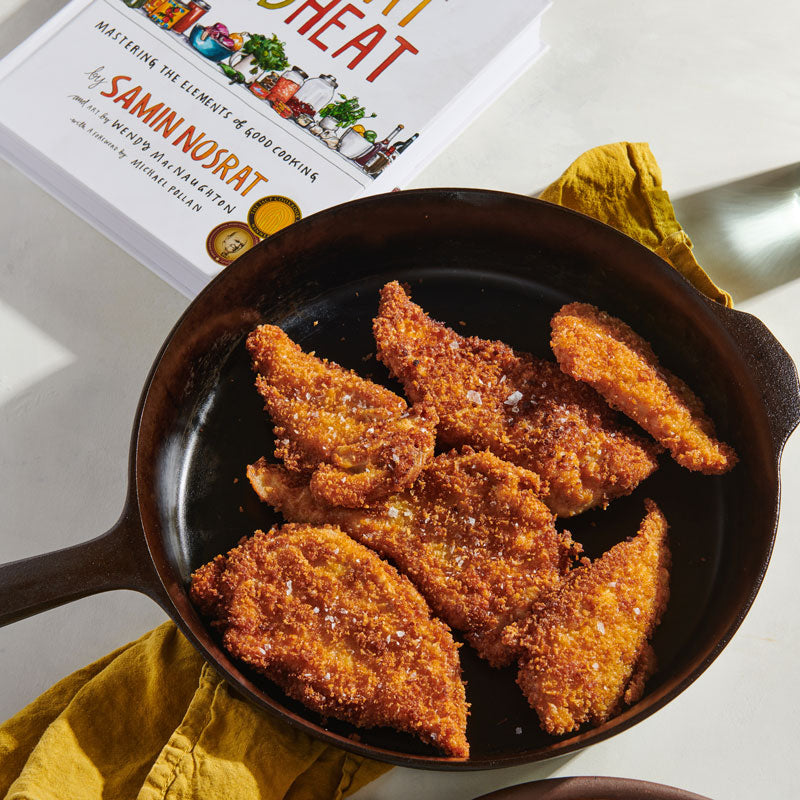“Treat croutons like steak,” is some of the most surprising—and illuminating—cooking advice we’ve received. The chef who gifted us this paradox cooks exemplary versions of both, and his elucidation changed the way we approach skillet-fried (or oven-baked) bread forever. Let’s break it down:

Know your cut.
Not all cuts of beef cook the same, just different breads will yield different textures and cooking times when making croutons. Our ideal loaf for croutons has an airy crumb and is torn into shards—not diced into cubes!—to better grab any added seasonings and flavorings. And because chaos is more fun than order.
Use plenty of oil.
While we don’t deep-fry our steaks, we use a generous amount of oil when cooking them in a Field Skillet, which both ensures an evenly browned exterior and helps to season the skillet. The same goes for croutons, though bread absorbs fat rather than releases it, so you might need to add extra oil or butter during the cooking process.
Sear, don’t slow cook.
Sear, don’t slow cook. When cooking steaks, we use high heat (and in cast iron!) to build a deeply browned crust before the interior is overcooked. Ditto croutons, though at a slightly lower heat.
Don’t crowd the pan.
For the same reason you wouldn’t crowd steaks together in a pan, you shouldn’t crowd croutons either. Steam is the enemy of crunch.
Don’t overdo it.
While it’s obvious that a well-done steak is tougher than a medium-rare one, so too are overcooked croutons. Our ideal crouton texture is crispy on the outside with a slightly spongy interior—it should crunch when you bite into it, but retain enough softness to yield to your teeth. In other words, if your croutons shatter when you stab them with a fork, they’re overcooked.
Add flavor before and after cooking.
We flavor steaks before cooking with salt and pepper, spice rubs, and/or marinades before we cook them, and finish steaks with sauces, compound butters, and finishing salts and oils after. A similar approach works for croutons: add flavorings early in the process (as with the garlic, anchovies, and chile flakes in our recipe below), and more delicate flavors and ingredients—such as lemon zest, chopped herbs, or finely grated cheese—as soon as the bread is finished cooking.
Recipe: Skillet-Fried Croutons
Ingredients
4 tablespoons unsalted butter
4 garlic cloves, smashed
2 anchovies (optional)
Pinch of red-pepper flakes (optional)
2 tablespoons extra-virgin olive oil, plus more as needed
Kosher salt and freshly ground black pepper
8 ounces crustless sourdough (or other hearty, airy bread), roughly torn into 1-inch pieces (about 4 cups)
Optional finishes: Finely grated lemon zest, finely chopped herbs, finely grated Parmesan (or other hard) cheese
Tools
Resources
The Field Method for Cast Iron Care
Instructions
Preheat a No.8 (or larger) Field Skillet over medium heat. Add the butter, garlic, anchovies (if using) and red-pepper flakes (if using) and cook, stirring frequently, until the butter smells nutty and the garlic is lightly browned, 5 to 7 minutes. Remove the garlic and discard.
Add the olive oil and bread. Season the bread with salt and pepper and cook, stirring occasionally, until golden brown on all sides, 8 to 10 minutes. If the bread absorbs all of the oil, add more, a drizzle at a time, as needed. Also, if the bread begins to brown too quickly, lower the heat a touch.
Turn off the heat and add any optional finishes, then toss briefly. Transfer the croutons to a baking sheet and toss with any let cool. The croutons can be stored in an airtight container for up to 1 week.
Seasoning Rating: Better
Heating oil and toasting bread will help easy your skillet into top shape. Even though this recipe is easy on your skillet, you'll want to give it a quick wash—unless a hint anchovy and garlic will be welcome in your next meal.
Seasoning Ratings:
Best—These dishes are the best options for building resilient seasoning, and surefire choices for getting tricky pans back on track.
Better—The best way to keep your skillet in great shape is to cook frequently, and cast iron-friendly dishes like these are your bread and butter.
Safe—These recipes won't strip seasoning away from your pan, but won't really add any, either.
OK—Be sure to clean up promptly. Recipes with this rating might feature acidic ingredients which can affect seasoning if not washed soon after cooking.




